Employee Motivation and Job Performance Report - MGNT803
VerifiedAdded on 2021/09/17
|9
|2728
|480
Report
AI Summary
This report examines the critical relationship between employee motivation and job performance within organizational settings. It begins by defining organizational behavior and highlighting the significance of employee motivation, acknowledging the low engagement rates often observed in workplaces. The report delves into the impact of motivation on job performance, emphasizing the manager's role in fostering a positive work environment and applying motivational theories such as Maslow's Hierarchy of Needs. It explores the influence of the quality of work life on employee attitudes and productivity, discussing factors like job satisfaction and security. The report then reviews literature on employee motivation, summarizing key findings and their implications for managers, including the importance of rewards, recognition, and work-life balance. The research highlights how managers can improve employee motivation. Overall, the report underscores the importance of employee motivation for achieving organizational goals and enhancing overall productivity.
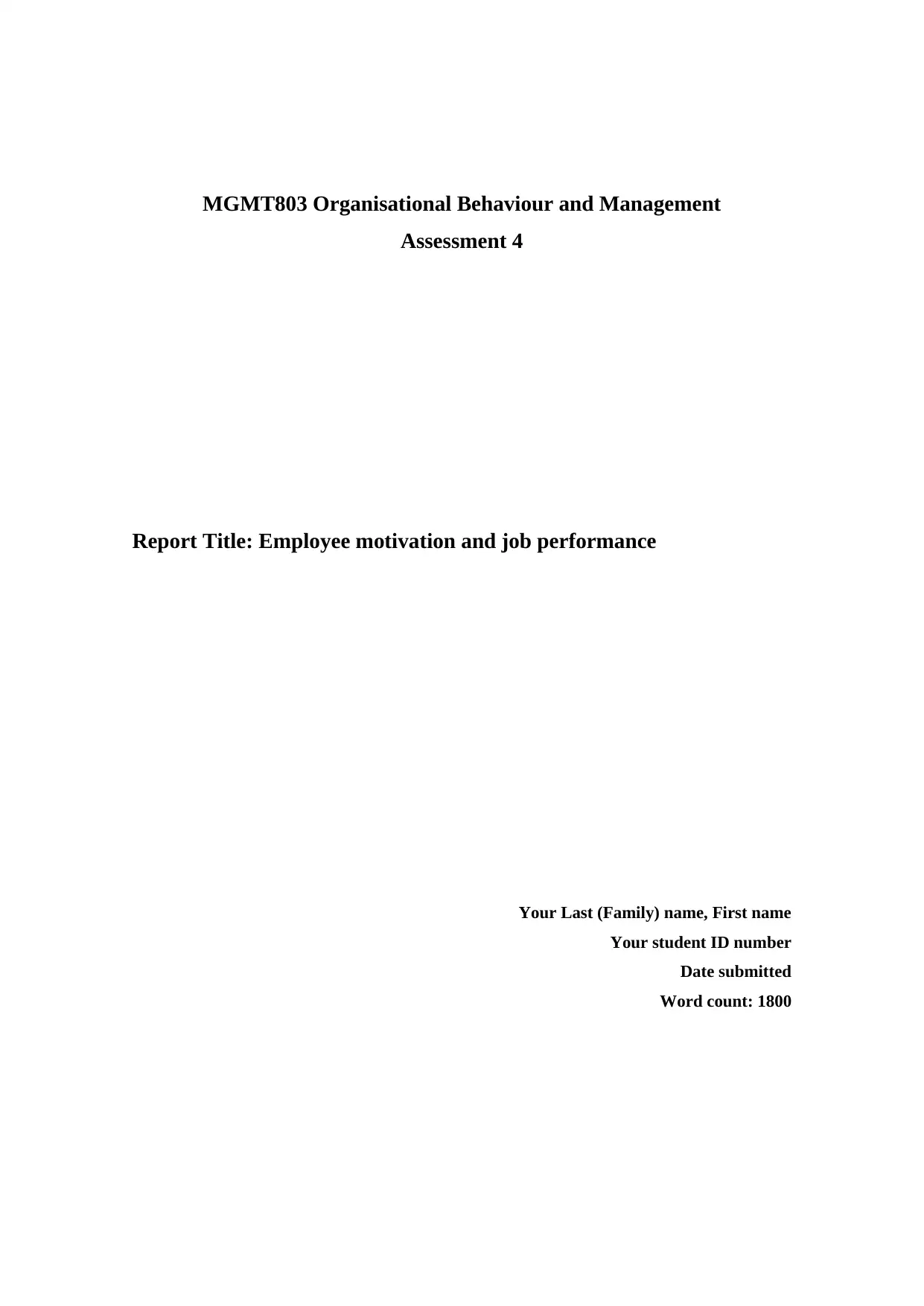
MGMT803 Organisational Behaviour and Management
Assessment 4
Report Title: Employee motivation and job performance
Your Last (Family) name, First name
Your student ID number
Date submitted
Word count: 1800
Assessment 4
Report Title: Employee motivation and job performance
Your Last (Family) name, First name
Your student ID number
Date submitted
Word count: 1800
Paraphrase This Document
Need a fresh take? Get an instant paraphrase of this document with our AI Paraphraser
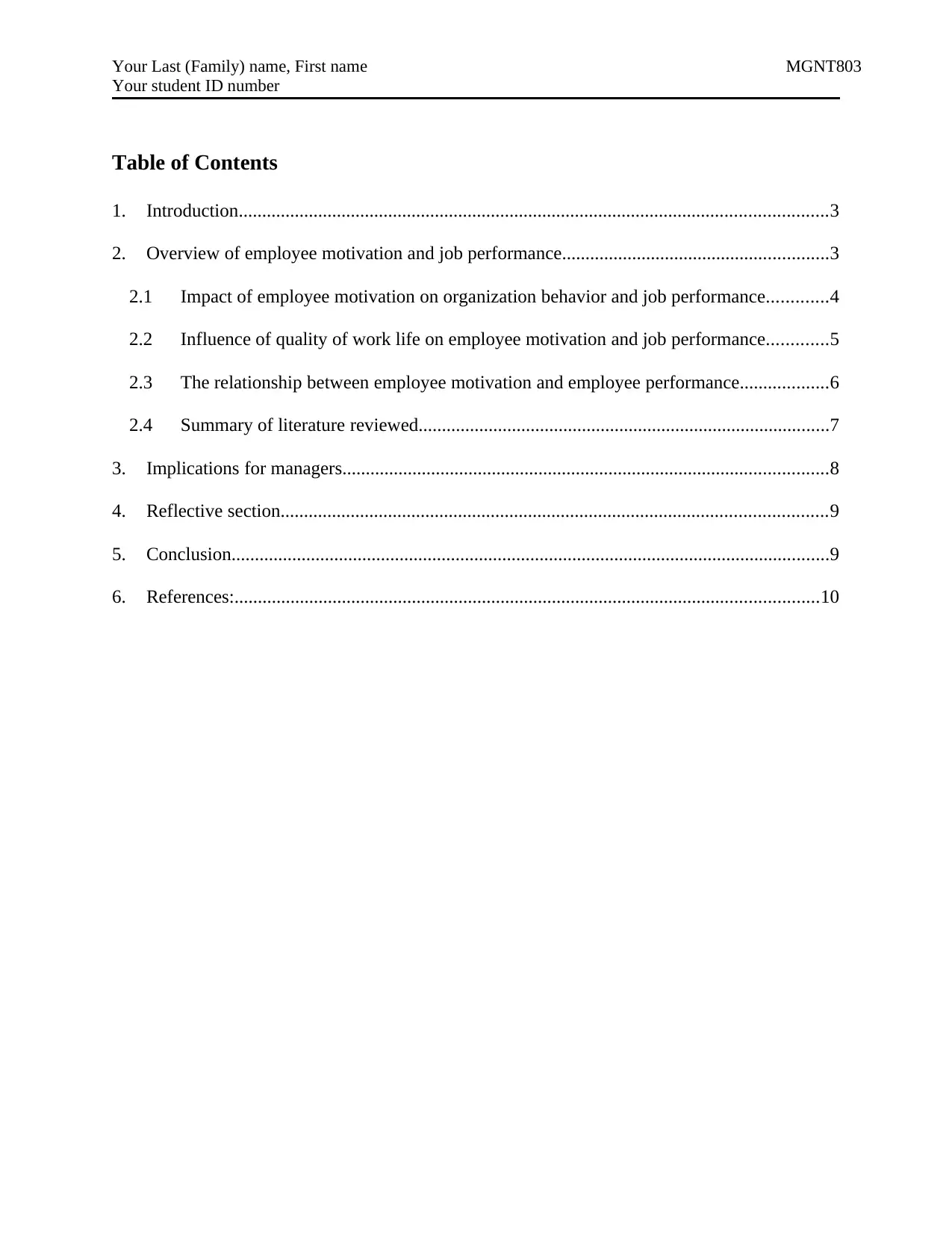
Your Last (Family) name, First name MGNT803
Your student ID number
Table of Contents
1. Introduction..............................................................................................................................3
2. Overview of employee motivation and job performance.........................................................3
2.1 Impact of employee motivation on organization behavior and job performance.............4
2.2 Influence of quality of work life on employee motivation and job performance.............5
2.3 The relationship between employee motivation and employee performance...................6
2.4 Summary of literature reviewed........................................................................................7
3. Implications for managers........................................................................................................8
4. Reflective section.....................................................................................................................9
5. Conclusion................................................................................................................................9
6. References:.............................................................................................................................10
Your student ID number
Table of Contents
1. Introduction..............................................................................................................................3
2. Overview of employee motivation and job performance.........................................................3
2.1 Impact of employee motivation on organization behavior and job performance.............4
2.2 Influence of quality of work life on employee motivation and job performance.............5
2.3 The relationship between employee motivation and employee performance...................6
2.4 Summary of literature reviewed........................................................................................7
3. Implications for managers........................................................................................................8
4. Reflective section.....................................................................................................................9
5. Conclusion................................................................................................................................9
6. References:.............................................................................................................................10
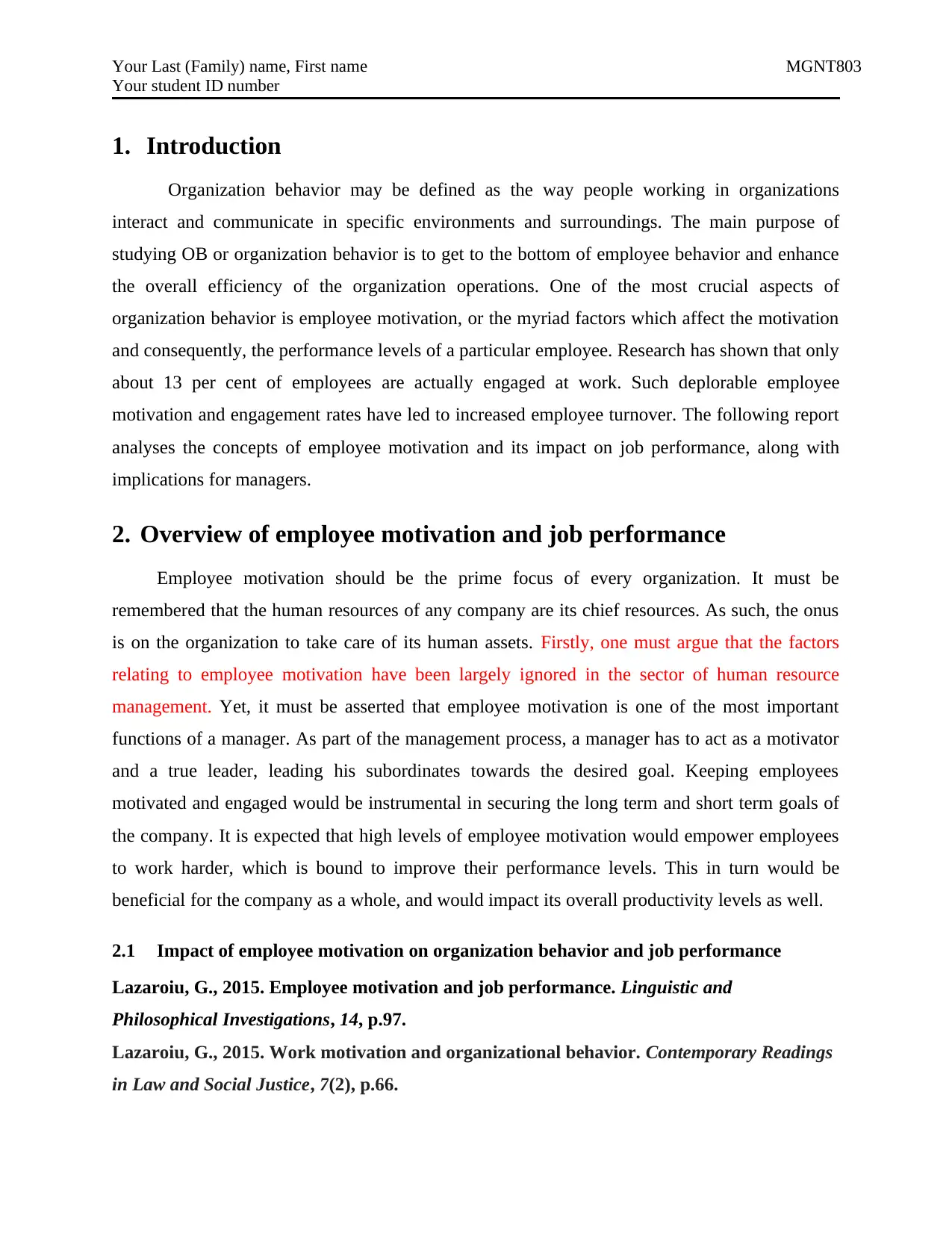
Your Last (Family) name, First name MGNT803
Your student ID number
1. Introduction
Organization behavior may be defined as the way people working in organizations
interact and communicate in specific environments and surroundings. The main purpose of
studying OB or organization behavior is to get to the bottom of employee behavior and enhance
the overall efficiency of the organization operations. One of the most crucial aspects of
organization behavior is employee motivation, or the myriad factors which affect the motivation
and consequently, the performance levels of a particular employee. Research has shown that only
about 13 per cent of employees are actually engaged at work. Such deplorable employee
motivation and engagement rates have led to increased employee turnover. The following report
analyses the concepts of employee motivation and its impact on job performance, along with
implications for managers.
2. Overview of employee motivation and job performance
Employee motivation should be the prime focus of every organization. It must be
remembered that the human resources of any company are its chief resources. As such, the onus
is on the organization to take care of its human assets. Firstly, one must argue that the factors
relating to employee motivation have been largely ignored in the sector of human resource
management. Yet, it must be asserted that employee motivation is one of the most important
functions of a manager. As part of the management process, a manager has to act as a motivator
and a true leader, leading his subordinates towards the desired goal. Keeping employees
motivated and engaged would be instrumental in securing the long term and short term goals of
the company. It is expected that high levels of employee motivation would empower employees
to work harder, which is bound to improve their performance levels. This in turn would be
beneficial for the company as a whole, and would impact its overall productivity levels as well.
2.1 Impact of employee motivation on organization behavior and job performance
Lazaroiu, G., 2015. Employee motivation and job performance. Linguistic and
Philosophical Investigations, 14, p.97.
Lazaroiu, G., 2015. Work motivation and organizational behavior. Contemporary Readings
in Law and Social Justice, 7(2), p.66.
Your student ID number
1. Introduction
Organization behavior may be defined as the way people working in organizations
interact and communicate in specific environments and surroundings. The main purpose of
studying OB or organization behavior is to get to the bottom of employee behavior and enhance
the overall efficiency of the organization operations. One of the most crucial aspects of
organization behavior is employee motivation, or the myriad factors which affect the motivation
and consequently, the performance levels of a particular employee. Research has shown that only
about 13 per cent of employees are actually engaged at work. Such deplorable employee
motivation and engagement rates have led to increased employee turnover. The following report
analyses the concepts of employee motivation and its impact on job performance, along with
implications for managers.
2. Overview of employee motivation and job performance
Employee motivation should be the prime focus of every organization. It must be
remembered that the human resources of any company are its chief resources. As such, the onus
is on the organization to take care of its human assets. Firstly, one must argue that the factors
relating to employee motivation have been largely ignored in the sector of human resource
management. Yet, it must be asserted that employee motivation is one of the most important
functions of a manager. As part of the management process, a manager has to act as a motivator
and a true leader, leading his subordinates towards the desired goal. Keeping employees
motivated and engaged would be instrumental in securing the long term and short term goals of
the company. It is expected that high levels of employee motivation would empower employees
to work harder, which is bound to improve their performance levels. This in turn would be
beneficial for the company as a whole, and would impact its overall productivity levels as well.
2.1 Impact of employee motivation on organization behavior and job performance
Lazaroiu, G., 2015. Employee motivation and job performance. Linguistic and
Philosophical Investigations, 14, p.97.
Lazaroiu, G., 2015. Work motivation and organizational behavior. Contemporary Readings
in Law and Social Justice, 7(2), p.66.
⊘ This is a preview!⊘
Do you want full access?
Subscribe today to unlock all pages.

Trusted by 1+ million students worldwide
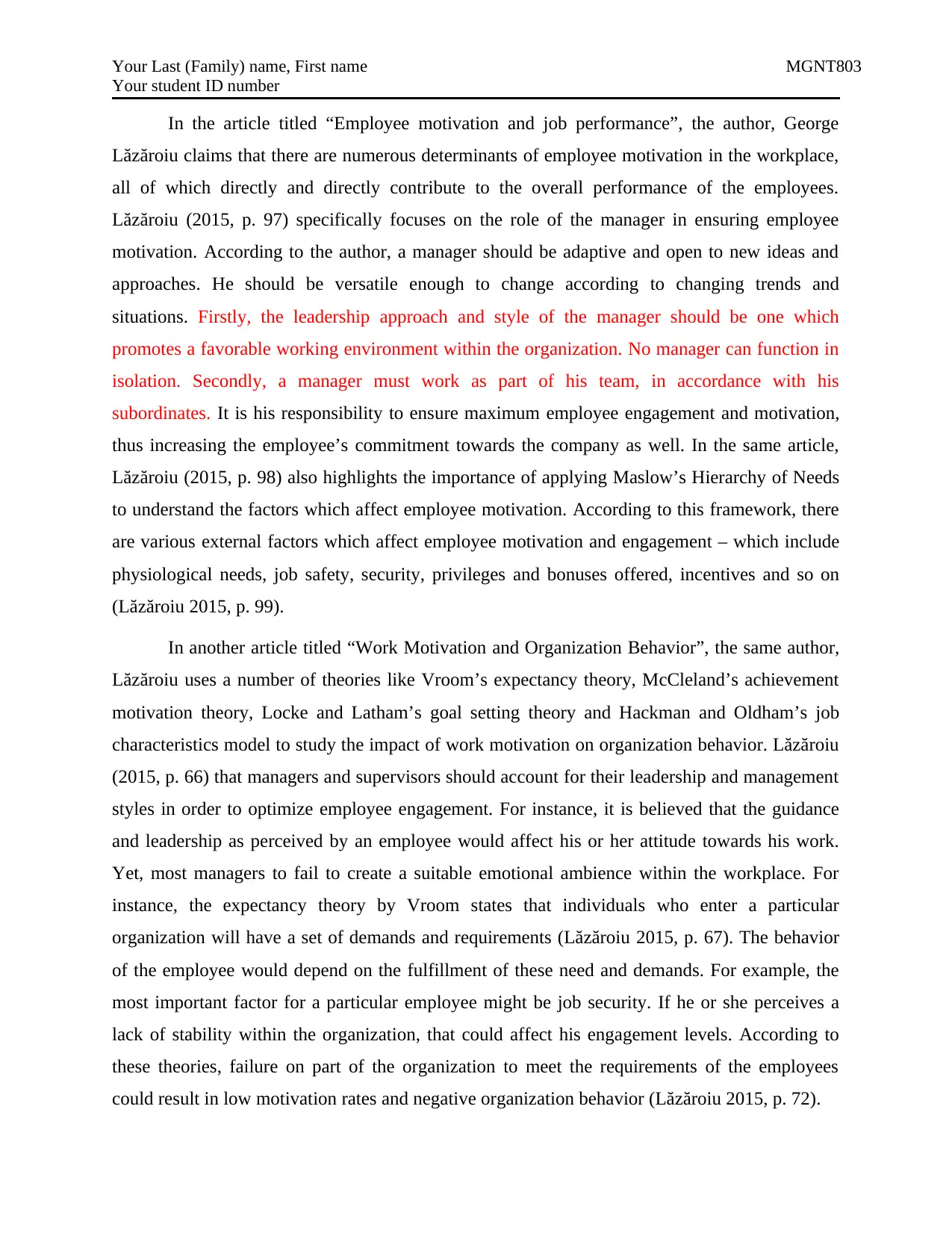
Your Last (Family) name, First name MGNT803
Your student ID number
In the article titled “Employee motivation and job performance”, the author, George
Lăzăroiu claims that there are numerous determinants of employee motivation in the workplace,
all of which directly and directly contribute to the overall performance of the employees.
Lăzăroiu (2015, p. 97) specifically focuses on the role of the manager in ensuring employee
motivation. According to the author, a manager should be adaptive and open to new ideas and
approaches. He should be versatile enough to change according to changing trends and
situations. Firstly, the leadership approach and style of the manager should be one which
promotes a favorable working environment within the organization. No manager can function in
isolation. Secondly, a manager must work as part of his team, in accordance with his
subordinates. It is his responsibility to ensure maximum employee engagement and motivation,
thus increasing the employee’s commitment towards the company as well. In the same article,
Lăzăroiu (2015, p. 98) also highlights the importance of applying Maslow’s Hierarchy of Needs
to understand the factors which affect employee motivation. According to this framework, there
are various external factors which affect employee motivation and engagement – which include
physiological needs, job safety, security, privileges and bonuses offered, incentives and so on
(Lăzăroiu 2015, p. 99).
In another article titled “Work Motivation and Organization Behavior”, the same author,
Lăzăroiu uses a number of theories like Vroom’s expectancy theory, McCleland’s achievement
motivation theory, Locke and Latham’s goal setting theory and Hackman and Oldham’s job
characteristics model to study the impact of work motivation on organization behavior. Lăzăroiu
(2015, p. 66) that managers and supervisors should account for their leadership and management
styles in order to optimize employee engagement. For instance, it is believed that the guidance
and leadership as perceived by an employee would affect his or her attitude towards his work.
Yet, most managers to fail to create a suitable emotional ambience within the workplace. For
instance, the expectancy theory by Vroom states that individuals who enter a particular
organization will have a set of demands and requirements (Lăzăroiu 2015, p. 67). The behavior
of the employee would depend on the fulfillment of these need and demands. For example, the
most important factor for a particular employee might be job security. If he or she perceives a
lack of stability within the organization, that could affect his engagement levels. According to
these theories, failure on part of the organization to meet the requirements of the employees
could result in low motivation rates and negative organization behavior (Lăzăroiu 2015, p. 72).
Your student ID number
In the article titled “Employee motivation and job performance”, the author, George
Lăzăroiu claims that there are numerous determinants of employee motivation in the workplace,
all of which directly and directly contribute to the overall performance of the employees.
Lăzăroiu (2015, p. 97) specifically focuses on the role of the manager in ensuring employee
motivation. According to the author, a manager should be adaptive and open to new ideas and
approaches. He should be versatile enough to change according to changing trends and
situations. Firstly, the leadership approach and style of the manager should be one which
promotes a favorable working environment within the organization. No manager can function in
isolation. Secondly, a manager must work as part of his team, in accordance with his
subordinates. It is his responsibility to ensure maximum employee engagement and motivation,
thus increasing the employee’s commitment towards the company as well. In the same article,
Lăzăroiu (2015, p. 98) also highlights the importance of applying Maslow’s Hierarchy of Needs
to understand the factors which affect employee motivation. According to this framework, there
are various external factors which affect employee motivation and engagement – which include
physiological needs, job safety, security, privileges and bonuses offered, incentives and so on
(Lăzăroiu 2015, p. 99).
In another article titled “Work Motivation and Organization Behavior”, the same author,
Lăzăroiu uses a number of theories like Vroom’s expectancy theory, McCleland’s achievement
motivation theory, Locke and Latham’s goal setting theory and Hackman and Oldham’s job
characteristics model to study the impact of work motivation on organization behavior. Lăzăroiu
(2015, p. 66) that managers and supervisors should account for their leadership and management
styles in order to optimize employee engagement. For instance, it is believed that the guidance
and leadership as perceived by an employee would affect his or her attitude towards his work.
Yet, most managers to fail to create a suitable emotional ambience within the workplace. For
instance, the expectancy theory by Vroom states that individuals who enter a particular
organization will have a set of demands and requirements (Lăzăroiu 2015, p. 67). The behavior
of the employee would depend on the fulfillment of these need and demands. For example, the
most important factor for a particular employee might be job security. If he or she perceives a
lack of stability within the organization, that could affect his engagement levels. According to
these theories, failure on part of the organization to meet the requirements of the employees
could result in low motivation rates and negative organization behavior (Lăzăroiu 2015, p. 72).
Paraphrase This Document
Need a fresh take? Get an instant paraphrase of this document with our AI Paraphraser
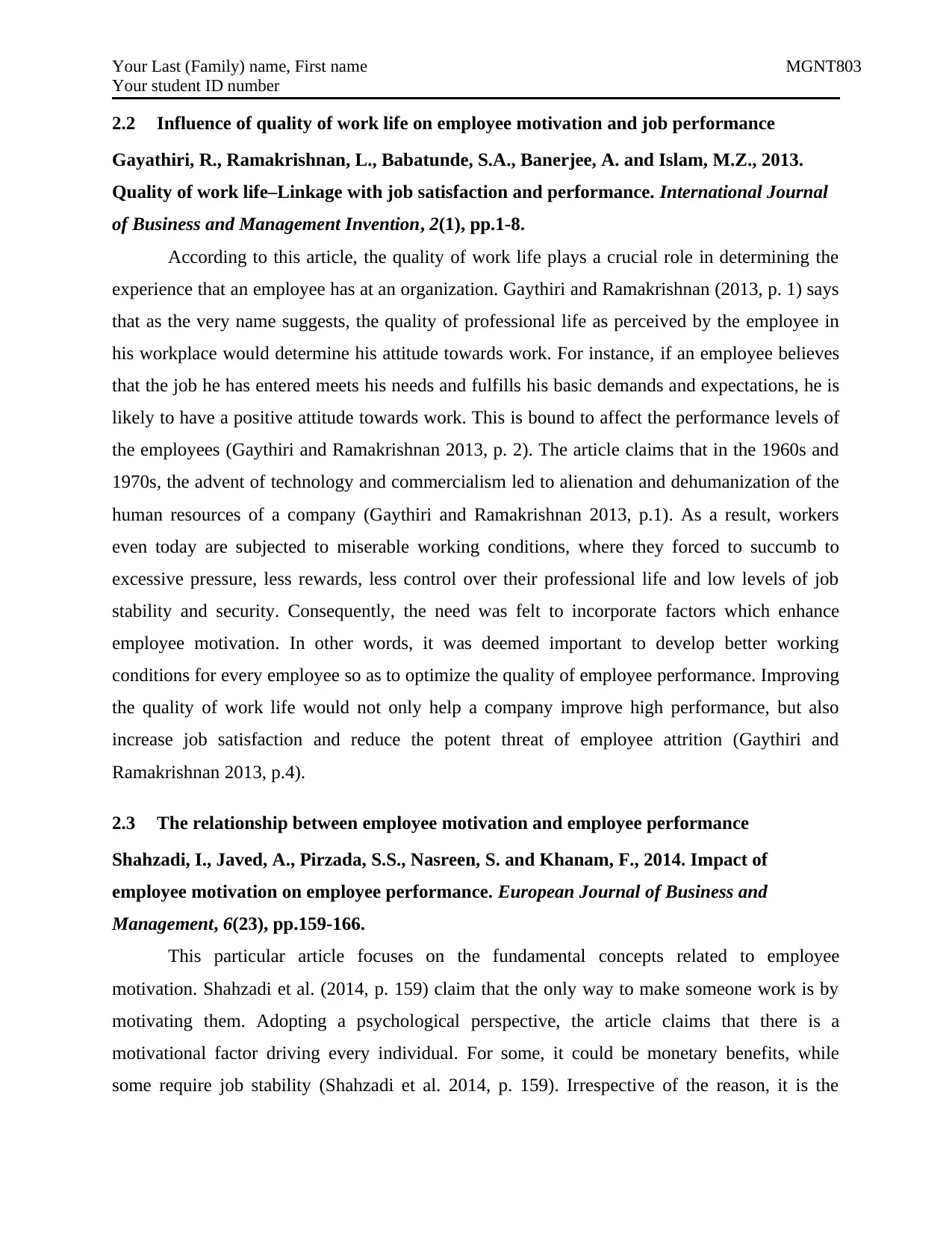
Your Last (Family) name, First name MGNT803
Your student ID number
2.2 Influence of quality of work life on employee motivation and job performance
Gayathiri, R., Ramakrishnan, L., Babatunde, S.A., Banerjee, A. and Islam, M.Z., 2013.
Quality of work life–Linkage with job satisfaction and performance. International Journal
of Business and Management Invention, 2(1), pp.1-8.
According to this article, the quality of work life plays a crucial role in determining the
experience that an employee has at an organization. Gaythiri and Ramakrishnan (2013, p. 1) says
that as the very name suggests, the quality of professional life as perceived by the employee in
his workplace would determine his attitude towards work. For instance, if an employee believes
that the job he has entered meets his needs and fulfills his basic demands and expectations, he is
likely to have a positive attitude towards work. This is bound to affect the performance levels of
the employees (Gaythiri and Ramakrishnan 2013, p. 2). The article claims that in the 1960s and
1970s, the advent of technology and commercialism led to alienation and dehumanization of the
human resources of a company (Gaythiri and Ramakrishnan 2013, p.1). As a result, workers
even today are subjected to miserable working conditions, where they forced to succumb to
excessive pressure, less rewards, less control over their professional life and low levels of job
stability and security. Consequently, the need was felt to incorporate factors which enhance
employee motivation. In other words, it was deemed important to develop better working
conditions for every employee so as to optimize the quality of employee performance. Improving
the quality of work life would not only help a company improve high performance, but also
increase job satisfaction and reduce the potent threat of employee attrition (Gaythiri and
Ramakrishnan 2013, p.4).
2.3 The relationship between employee motivation and employee performance
Shahzadi, I., Javed, A., Pirzada, S.S., Nasreen, S. and Khanam, F., 2014. Impact of
employee motivation on employee performance. European Journal of Business and
Management, 6(23), pp.159-166.
This particular article focuses on the fundamental concepts related to employee
motivation. Shahzadi et al. (2014, p. 159) claim that the only way to make someone work is by
motivating them. Adopting a psychological perspective, the article claims that there is a
motivational factor driving every individual. For some, it could be monetary benefits, while
some require job stability (Shahzadi et al. 2014, p. 159). Irrespective of the reason, it is the
Your student ID number
2.2 Influence of quality of work life on employee motivation and job performance
Gayathiri, R., Ramakrishnan, L., Babatunde, S.A., Banerjee, A. and Islam, M.Z., 2013.
Quality of work life–Linkage with job satisfaction and performance. International Journal
of Business and Management Invention, 2(1), pp.1-8.
According to this article, the quality of work life plays a crucial role in determining the
experience that an employee has at an organization. Gaythiri and Ramakrishnan (2013, p. 1) says
that as the very name suggests, the quality of professional life as perceived by the employee in
his workplace would determine his attitude towards work. For instance, if an employee believes
that the job he has entered meets his needs and fulfills his basic demands and expectations, he is
likely to have a positive attitude towards work. This is bound to affect the performance levels of
the employees (Gaythiri and Ramakrishnan 2013, p. 2). The article claims that in the 1960s and
1970s, the advent of technology and commercialism led to alienation and dehumanization of the
human resources of a company (Gaythiri and Ramakrishnan 2013, p.1). As a result, workers
even today are subjected to miserable working conditions, where they forced to succumb to
excessive pressure, less rewards, less control over their professional life and low levels of job
stability and security. Consequently, the need was felt to incorporate factors which enhance
employee motivation. In other words, it was deemed important to develop better working
conditions for every employee so as to optimize the quality of employee performance. Improving
the quality of work life would not only help a company improve high performance, but also
increase job satisfaction and reduce the potent threat of employee attrition (Gaythiri and
Ramakrishnan 2013, p.4).
2.3 The relationship between employee motivation and employee performance
Shahzadi, I., Javed, A., Pirzada, S.S., Nasreen, S. and Khanam, F., 2014. Impact of
employee motivation on employee performance. European Journal of Business and
Management, 6(23), pp.159-166.
This particular article focuses on the fundamental concepts related to employee
motivation. Shahzadi et al. (2014, p. 159) claim that the only way to make someone work is by
motivating them. Adopting a psychological perspective, the article claims that there is a
motivational factor driving every individual. For some, it could be monetary benefits, while
some require job stability (Shahzadi et al. 2014, p. 159). Irrespective of the reason, it is the
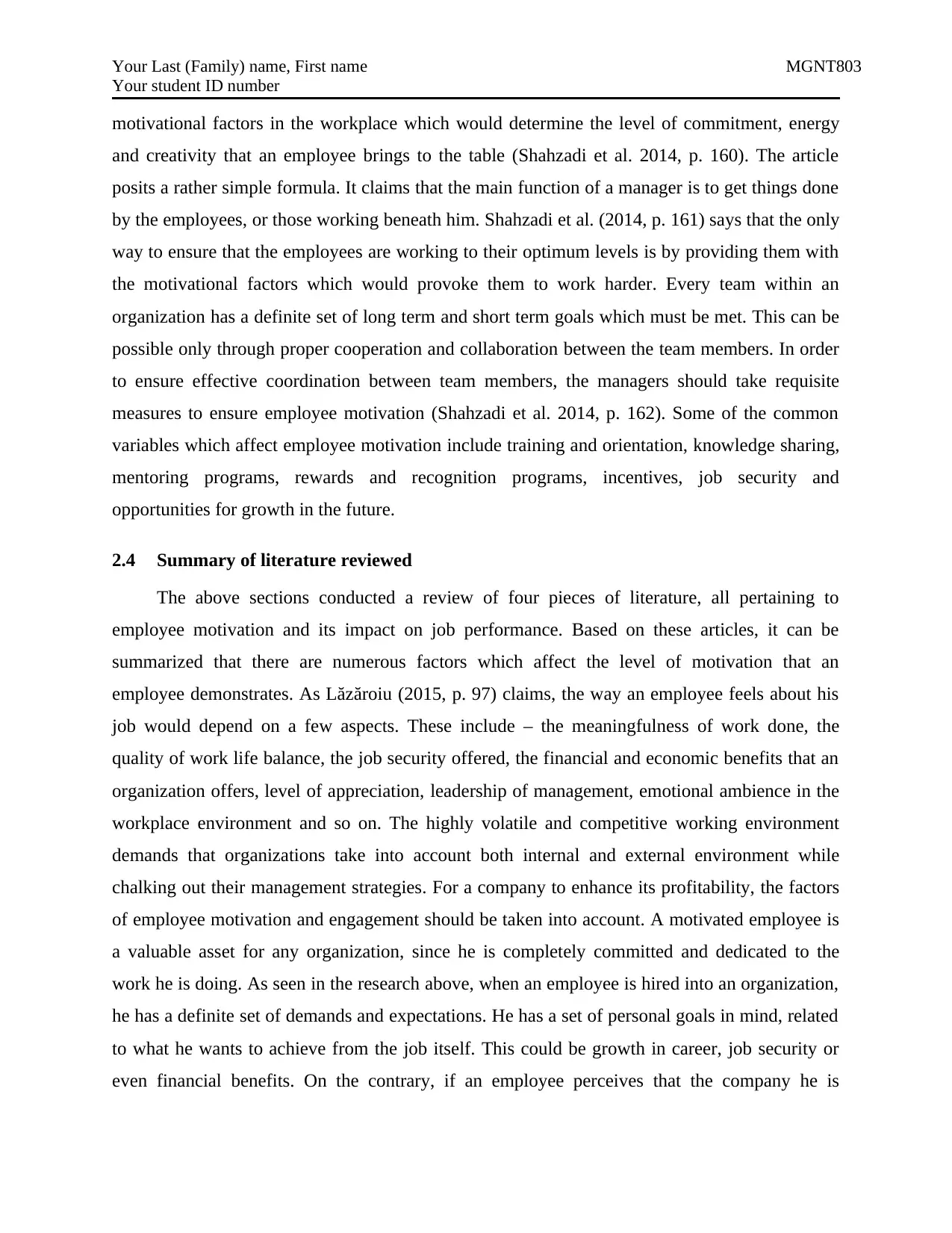
Your Last (Family) name, First name MGNT803
Your student ID number
motivational factors in the workplace which would determine the level of commitment, energy
and creativity that an employee brings to the table (Shahzadi et al. 2014, p. 160). The article
posits a rather simple formula. It claims that the main function of a manager is to get things done
by the employees, or those working beneath him. Shahzadi et al. (2014, p. 161) says that the only
way to ensure that the employees are working to their optimum levels is by providing them with
the motivational factors which would provoke them to work harder. Every team within an
organization has a definite set of long term and short term goals which must be met. This can be
possible only through proper cooperation and collaboration between the team members. In order
to ensure effective coordination between team members, the managers should take requisite
measures to ensure employee motivation (Shahzadi et al. 2014, p. 162). Some of the common
variables which affect employee motivation include training and orientation, knowledge sharing,
mentoring programs, rewards and recognition programs, incentives, job security and
opportunities for growth in the future.
2.4 Summary of literature reviewed
The above sections conducted a review of four pieces of literature, all pertaining to
employee motivation and its impact on job performance. Based on these articles, it can be
summarized that there are numerous factors which affect the level of motivation that an
employee demonstrates. As Lăzăroiu (2015, p. 97) claims, the way an employee feels about his
job would depend on a few aspects. These include – the meaningfulness of work done, the
quality of work life balance, the job security offered, the financial and economic benefits that an
organization offers, level of appreciation, leadership of management, emotional ambience in the
workplace environment and so on. The highly volatile and competitive working environment
demands that organizations take into account both internal and external environment while
chalking out their management strategies. For a company to enhance its profitability, the factors
of employee motivation and engagement should be taken into account. A motivated employee is
a valuable asset for any organization, since he is completely committed and dedicated to the
work he is doing. As seen in the research above, when an employee is hired into an organization,
he has a definite set of demands and expectations. He has a set of personal goals in mind, related
to what he wants to achieve from the job itself. This could be growth in career, job security or
even financial benefits. On the contrary, if an employee perceives that the company he is
Your student ID number
motivational factors in the workplace which would determine the level of commitment, energy
and creativity that an employee brings to the table (Shahzadi et al. 2014, p. 160). The article
posits a rather simple formula. It claims that the main function of a manager is to get things done
by the employees, or those working beneath him. Shahzadi et al. (2014, p. 161) says that the only
way to ensure that the employees are working to their optimum levels is by providing them with
the motivational factors which would provoke them to work harder. Every team within an
organization has a definite set of long term and short term goals which must be met. This can be
possible only through proper cooperation and collaboration between the team members. In order
to ensure effective coordination between team members, the managers should take requisite
measures to ensure employee motivation (Shahzadi et al. 2014, p. 162). Some of the common
variables which affect employee motivation include training and orientation, knowledge sharing,
mentoring programs, rewards and recognition programs, incentives, job security and
opportunities for growth in the future.
2.4 Summary of literature reviewed
The above sections conducted a review of four pieces of literature, all pertaining to
employee motivation and its impact on job performance. Based on these articles, it can be
summarized that there are numerous factors which affect the level of motivation that an
employee demonstrates. As Lăzăroiu (2015, p. 97) claims, the way an employee feels about his
job would depend on a few aspects. These include – the meaningfulness of work done, the
quality of work life balance, the job security offered, the financial and economic benefits that an
organization offers, level of appreciation, leadership of management, emotional ambience in the
workplace environment and so on. The highly volatile and competitive working environment
demands that organizations take into account both internal and external environment while
chalking out their management strategies. For a company to enhance its profitability, the factors
of employee motivation and engagement should be taken into account. A motivated employee is
a valuable asset for any organization, since he is completely committed and dedicated to the
work he is doing. As seen in the research above, when an employee is hired into an organization,
he has a definite set of demands and expectations. He has a set of personal goals in mind, related
to what he wants to achieve from the job itself. This could be growth in career, job security or
even financial benefits. On the contrary, if an employee perceives that the company he is
⊘ This is a preview!⊘
Do you want full access?
Subscribe today to unlock all pages.

Trusted by 1+ million students worldwide
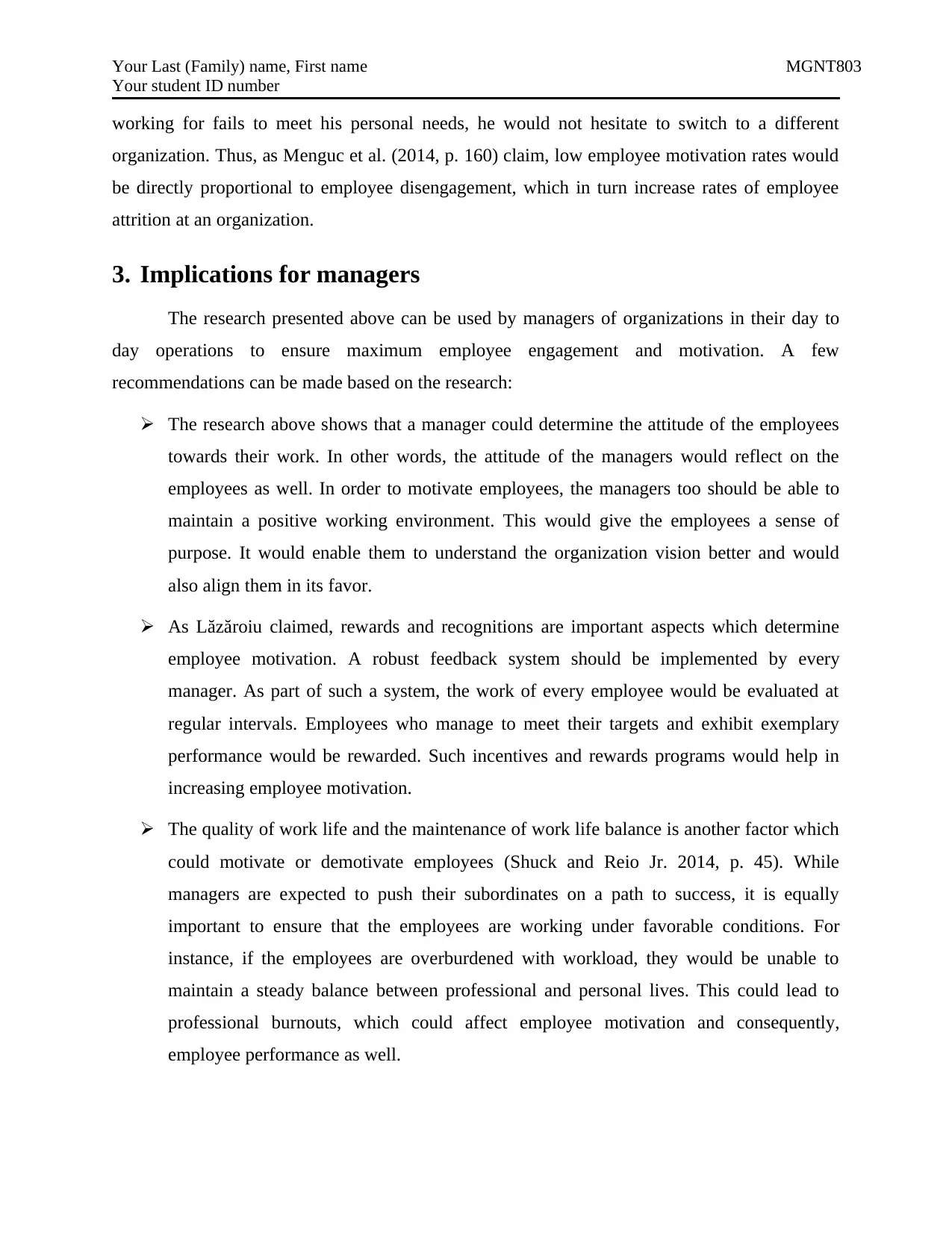
Your Last (Family) name, First name MGNT803
Your student ID number
working for fails to meet his personal needs, he would not hesitate to switch to a different
organization. Thus, as Menguc et al. (2014, p. 160) claim, low employee motivation rates would
be directly proportional to employee disengagement, which in turn increase rates of employee
attrition at an organization.
3. Implications for managers
The research presented above can be used by managers of organizations in their day to
day operations to ensure maximum employee engagement and motivation. A few
recommendations can be made based on the research:
The research above shows that a manager could determine the attitude of the employees
towards their work. In other words, the attitude of the managers would reflect on the
employees as well. In order to motivate employees, the managers too should be able to
maintain a positive working environment. This would give the employees a sense of
purpose. It would enable them to understand the organization vision better and would
also align them in its favor.
As Lăzăroiu claimed, rewards and recognitions are important aspects which determine
employee motivation. A robust feedback system should be implemented by every
manager. As part of such a system, the work of every employee would be evaluated at
regular intervals. Employees who manage to meet their targets and exhibit exemplary
performance would be rewarded. Such incentives and rewards programs would help in
increasing employee motivation.
The quality of work life and the maintenance of work life balance is another factor which
could motivate or demotivate employees (Shuck and Reio Jr. 2014, p. 45). While
managers are expected to push their subordinates on a path to success, it is equally
important to ensure that the employees are working under favorable conditions. For
instance, if the employees are overburdened with workload, they would be unable to
maintain a steady balance between professional and personal lives. This could lead to
professional burnouts, which could affect employee motivation and consequently,
employee performance as well.
Your student ID number
working for fails to meet his personal needs, he would not hesitate to switch to a different
organization. Thus, as Menguc et al. (2014, p. 160) claim, low employee motivation rates would
be directly proportional to employee disengagement, which in turn increase rates of employee
attrition at an organization.
3. Implications for managers
The research presented above can be used by managers of organizations in their day to
day operations to ensure maximum employee engagement and motivation. A few
recommendations can be made based on the research:
The research above shows that a manager could determine the attitude of the employees
towards their work. In other words, the attitude of the managers would reflect on the
employees as well. In order to motivate employees, the managers too should be able to
maintain a positive working environment. This would give the employees a sense of
purpose. It would enable them to understand the organization vision better and would
also align them in its favor.
As Lăzăroiu claimed, rewards and recognitions are important aspects which determine
employee motivation. A robust feedback system should be implemented by every
manager. As part of such a system, the work of every employee would be evaluated at
regular intervals. Employees who manage to meet their targets and exhibit exemplary
performance would be rewarded. Such incentives and rewards programs would help in
increasing employee motivation.
The quality of work life and the maintenance of work life balance is another factor which
could motivate or demotivate employees (Shuck and Reio Jr. 2014, p. 45). While
managers are expected to push their subordinates on a path to success, it is equally
important to ensure that the employees are working under favorable conditions. For
instance, if the employees are overburdened with workload, they would be unable to
maintain a steady balance between professional and personal lives. This could lead to
professional burnouts, which could affect employee motivation and consequently,
employee performance as well.
Paraphrase This Document
Need a fresh take? Get an instant paraphrase of this document with our AI Paraphraser
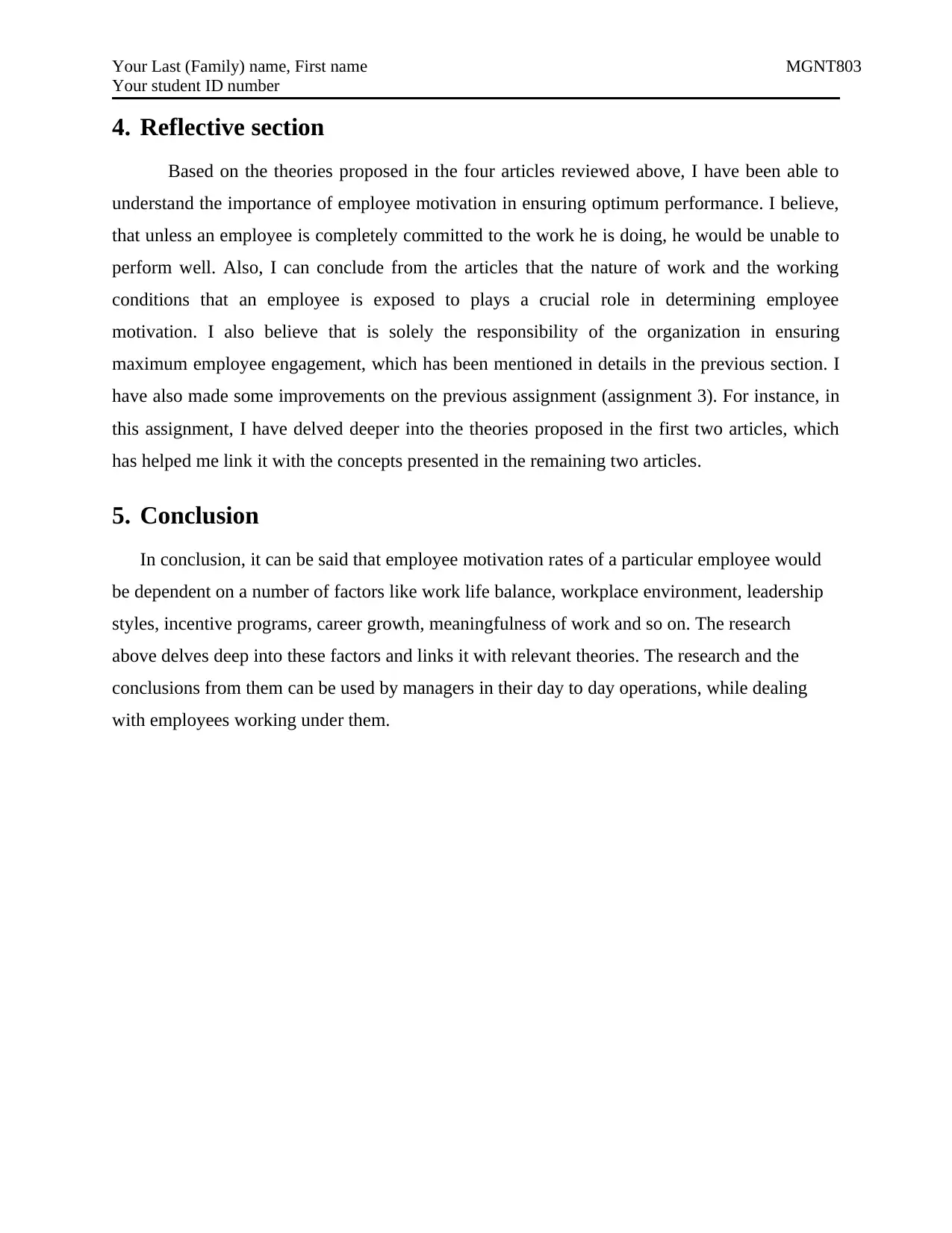
Your Last (Family) name, First name MGNT803
Your student ID number
4. Reflective section
Based on the theories proposed in the four articles reviewed above, I have been able to
understand the importance of employee motivation in ensuring optimum performance. I believe,
that unless an employee is completely committed to the work he is doing, he would be unable to
perform well. Also, I can conclude from the articles that the nature of work and the working
conditions that an employee is exposed to plays a crucial role in determining employee
motivation. I also believe that is solely the responsibility of the organization in ensuring
maximum employee engagement, which has been mentioned in details in the previous section. I
have also made some improvements on the previous assignment (assignment 3). For instance, in
this assignment, I have delved deeper into the theories proposed in the first two articles, which
has helped me link it with the concepts presented in the remaining two articles.
5. Conclusion
In conclusion, it can be said that employee motivation rates of a particular employee would
be dependent on a number of factors like work life balance, workplace environment, leadership
styles, incentive programs, career growth, meaningfulness of work and so on. The research
above delves deep into these factors and links it with relevant theories. The research and the
conclusions from them can be used by managers in their day to day operations, while dealing
with employees working under them.
Your student ID number
4. Reflective section
Based on the theories proposed in the four articles reviewed above, I have been able to
understand the importance of employee motivation in ensuring optimum performance. I believe,
that unless an employee is completely committed to the work he is doing, he would be unable to
perform well. Also, I can conclude from the articles that the nature of work and the working
conditions that an employee is exposed to plays a crucial role in determining employee
motivation. I also believe that is solely the responsibility of the organization in ensuring
maximum employee engagement, which has been mentioned in details in the previous section. I
have also made some improvements on the previous assignment (assignment 3). For instance, in
this assignment, I have delved deeper into the theories proposed in the first two articles, which
has helped me link it with the concepts presented in the remaining two articles.
5. Conclusion
In conclusion, it can be said that employee motivation rates of a particular employee would
be dependent on a number of factors like work life balance, workplace environment, leadership
styles, incentive programs, career growth, meaningfulness of work and so on. The research
above delves deep into these factors and links it with relevant theories. The research and the
conclusions from them can be used by managers in their day to day operations, while dealing
with employees working under them.
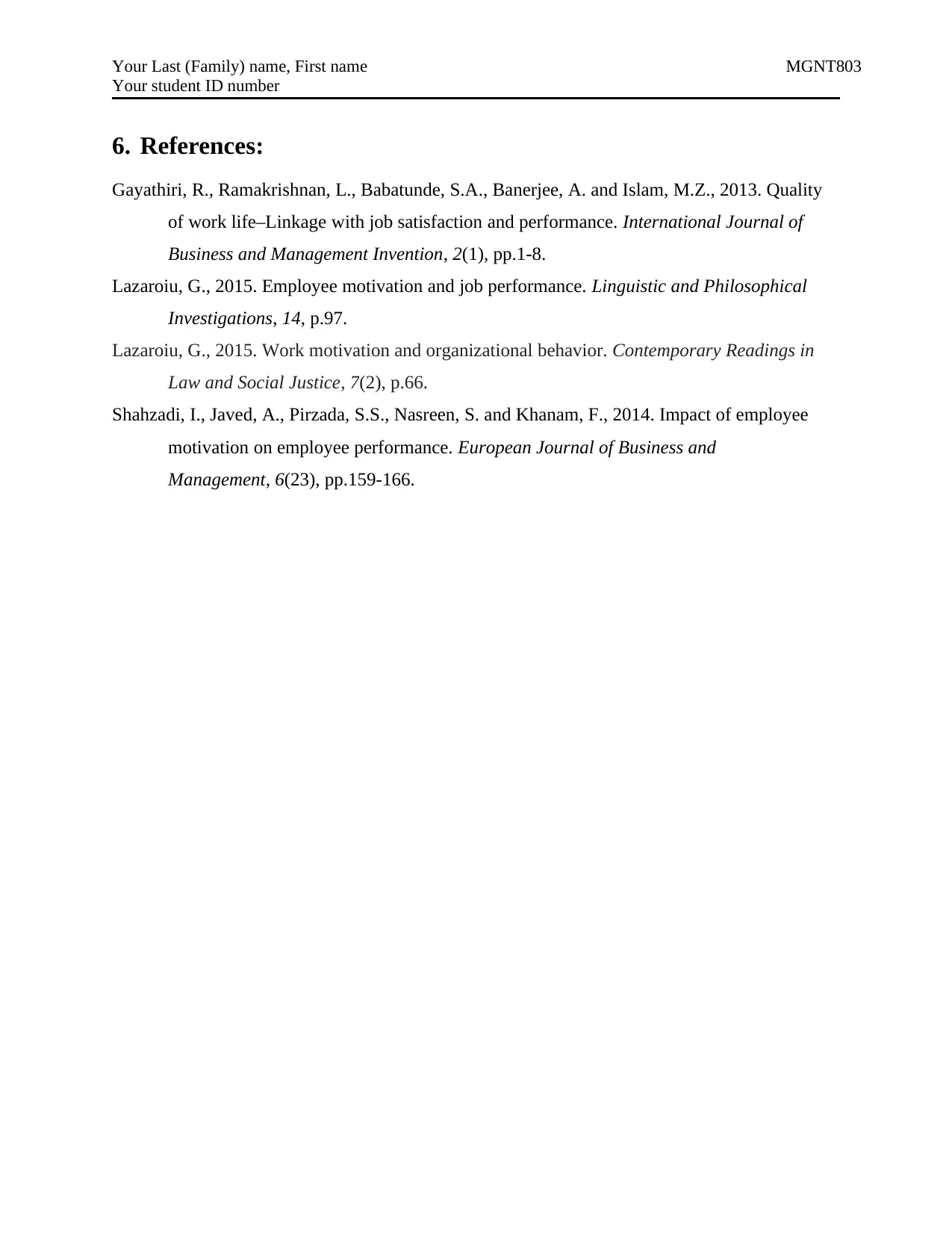
Your Last (Family) name, First name MGNT803
Your student ID number
6. References:
Gayathiri, R., Ramakrishnan, L., Babatunde, S.A., Banerjee, A. and Islam, M.Z., 2013. Quality
of work life–Linkage with job satisfaction and performance. International Journal of
Business and Management Invention, 2(1), pp.1-8.
Lazaroiu, G., 2015. Employee motivation and job performance. Linguistic and Philosophical
Investigations, 14, p.97.
Lazaroiu, G., 2015. Work motivation and organizational behavior. Contemporary Readings in
Law and Social Justice, 7(2), p.66.
Shahzadi, I., Javed, A., Pirzada, S.S., Nasreen, S. and Khanam, F., 2014. Impact of employee
motivation on employee performance. European Journal of Business and
Management, 6(23), pp.159-166.
Your student ID number
6. References:
Gayathiri, R., Ramakrishnan, L., Babatunde, S.A., Banerjee, A. and Islam, M.Z., 2013. Quality
of work life–Linkage with job satisfaction and performance. International Journal of
Business and Management Invention, 2(1), pp.1-8.
Lazaroiu, G., 2015. Employee motivation and job performance. Linguistic and Philosophical
Investigations, 14, p.97.
Lazaroiu, G., 2015. Work motivation and organizational behavior. Contemporary Readings in
Law and Social Justice, 7(2), p.66.
Shahzadi, I., Javed, A., Pirzada, S.S., Nasreen, S. and Khanam, F., 2014. Impact of employee
motivation on employee performance. European Journal of Business and
Management, 6(23), pp.159-166.
⊘ This is a preview!⊘
Do you want full access?
Subscribe today to unlock all pages.

Trusted by 1+ million students worldwide
1 out of 9
Related Documents
Your All-in-One AI-Powered Toolkit for Academic Success.
+13062052269
info@desklib.com
Available 24*7 on WhatsApp / Email
![[object Object]](/_next/static/media/star-bottom.7253800d.svg)
Unlock your academic potential
Copyright © 2020–2025 A2Z Services. All Rights Reserved. Developed and managed by ZUCOL.





